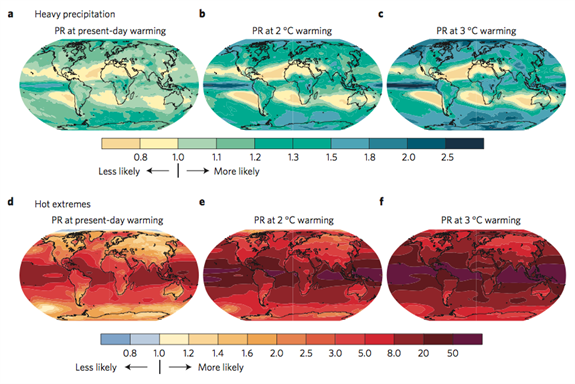Also discussed here: Human activity responsible for three out of four heat extremes, study finds (Roz Pidcock, The Carbon Brief, Apr. 27, 2015)
Today we review climate modeling research that examines the how the frequency of extreme weather events over the long term has and is being changed by the addition of greenhouse gases to the atmosphere. Results indicate that in addition to an average global warming of 0.85 C over the last 100 years that the probability of the temperature at a location exceeding a given threshold has tripled so that a daily maximum above 35C, say, that once occurred once in 3 years now occurs every year. When the global temperature has increased by 2C which is the present aim for international policy makers under existing climate change protocols, the probability of a hot day will increase 5 times compared to present day frequencies. Likewise the additional moisture that warmer air can carry has increased and this leads to heavier and more frequent rain storms and floods, especially in the tropics. While the link between climate warming and more frequent extreme events has been known in general terms for a long time, this is the first time that a quantitative number has been put on that- which has major impacts on insurance as well as on policy dealing with climate change.

Key Quotes:
“75% of extreme hot days and 18% of days with heavy rainfall worldwide can be explained by the warming we've seen over the industrial period….Global temperature today is about 0.85C above what it was before the industrial revolution”
"Warmer temperatures overall create more hot days, and warmer air can hold and transport more moisture, which at some point must come down. These physical principles have been known for decades." "This result has strong implications for the discussion of different mitigation targets in climate negotiations, where differences between targets are small in terms of global temperature, but large in terms of the probability of extremes."
"The idea that in a 2C world almost half of heavy rainfall events would not have occurred were it not for climate change is a sobering thought for policymakers seeking to mitigate and adapt to climate change." "The global view is relevant for a large country, for example, to estimate the risks of extreme weather overall, no matter where it happens, or for reinsurance, agriculture and food security, where the aggregated damages matter."
"The damage depends on how much infrastructure is there, on building standards, protection measures, on warning systems, disaster response, etc., so the same weather event can lead to much more or much less damage depending on what or who is there, and how those people are prepared and respond to that threat."
"I think we need to go one stage further and model the contribution of anthropogenic climate change to the actual impacts of extreme weather, and then compile a global inventory of harm, not just of meteorological events, if we are to arrive at an objective assessment of loss and damage due to anthropogenic climate change."







No comments:
Post a Comment